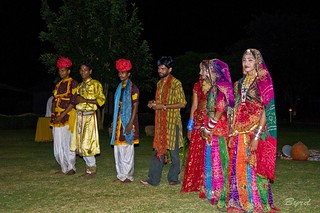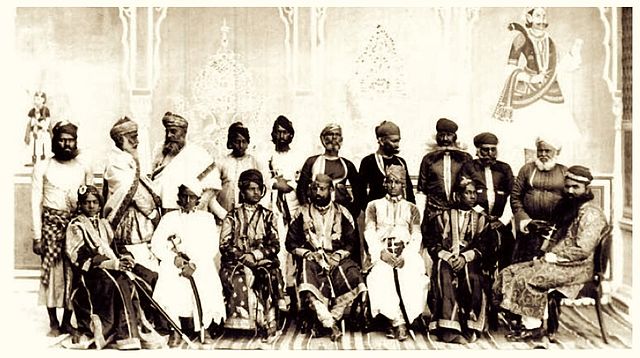Ref:- *Col. James Tod, Annals & Antiquities of Rajasthan, vol.-II, Rupa & Co.
*As narrated by Tulsiram Jaga (village Nimoda, district Sawai Madhopur)
GREATNESS OF BAIPLAWAT QUEEN
During Samnvat 1023 (at present Vikram Samnvat 2062), Alansingh Chanda
ruled Gangkhoh (at a distance 4 kos from Jaipur). Sode Rai (Sora Singh) prince
of Narwar (near Gwalior) died in fight with the Rathore Rajputs, though he won
the battle. His younger brother Tejsing usurped the power and deprived family of
Sode Rai of their inheritance. Taking notice of the devious character of Tejsing
and due to his fear, wife of Sode Rai, Pushpadeh (daughter of Panwar of Ujjain)
took the infant child Dhole Rai (who was then 8 months old) and left Narwar.
She was passing through a jungle. Being tired and hungry, she laid Dhole Rai on
ground and start plucking berries to eat. A serpent came and hooded the child to
shade him. The young Brahmin passing by noticed this miracle and searched for
the mother of the child who was hiding behind the bushes due to fear of stranger.
To the mother of Dhole Rai the Brahmin predicted bright future of the child, to
which she laughed. The Brahmin questioned her identity, to which she replied
‘aasman ke patki, dharti ke jheli’, i.e. thrown from the sky and embraced by the
earth. Looking to the destitute lady he took her along promising some job for
livelihood.
When he entered Gangkhoh along with the lady he asked the women
at panghat to take her to the queen and grant her a job.
They took her to the
Sodhe Rani (she belonged to Bhepdawat/Baiplawat gotra) who was elder queen of
Alansingh Chanda.
Here, Pushpadeh was granted a job of maid servant with an
exception pronounced by herself that she will not make bed for a man and wash
his clothes.
Alansingh Chanda adopted PUSHPADEH
Slowly as time passed, due to her sincerity she became trustworthy of the Sodhe
Rani. It was mandatory for the queen to prepare food for Alansingh because he
didn’t like his food to be cooked by servants. But one day, being happy with
Pushpadeh, just for a change the queen asked her to prepare the food. It was
then served to the king. As the king took one or two morsels of it he at once
recognized the change in taste of the food; it was delicious then ever before. He
called on the queen to report urgently and explains the reason. Feared of the
king, Sodhe Rani uttered the truth to which the maid servant Pushpadeh was
also summoned to the king.
Finally Alansingh got to know the truth and identity of
Pushpadeh and thus adopted her as his sister; and her son Dhole Rai his nephew. He ordered his queens that from today Pushpadeh will be rule the
premises of Gangkhoh and he himself will rule rest of the country.
As the time passed Dhole Rai attained the age of five years old and became a
very destructive child for every one. Daily their used to be complains from people
about his activities. He did not obey to his mother Pushpadeh also. When the
matter was taken to Alansingh, who disagreed to say anything to the child and
instead ordered to compensate the people for their losses.
When Dhole Rai
became 13 years old he asked horse from his maternal uncle Alansingh and got
it in gift.
During this period their was reign of Anangpal all over India with its capital at
Delhi. Every ruler had to pay royalty and taxes in his court to be in peace with
him. Anangpal had only two daughters and no son. The elder daughter was
Kamla and Rekko the younger one. Kamla had a son Jaisand Rathore, while
Rikko son was Prathviraj Chauhan. Since Anangpal had no male issue therefore
he adopted his grandson Prathviraj Chauhan and made his successor noticing
his qualities.
Way to Delhi
It was the duty of Alansingh Chanda to send eight persons to fill tanka in the
court of Anangpal at Delhi. On one occasion, Dhole Rai who was now fourteen
year old requested the king to permit him to go Delhi to pay for the royalties.
Taking the money of chauth he went alone to Delhi. On appearing in the court of
Anangpal to deposit the chauth and introduced himself as nephew of Alansingh
to which the king disagreed as he knew that there was no sister of Alansingh.
Finally Dhole Rai disclosed the truth. Being influenced with his personality he
was recruited into the army and retained at Delhi. By the age of sixteen he was
made officer of the army. The young Kacchhawa remained there for five years.
In the court of Alansingh Chanda was Bhima Rana (bard).
He went to Delhi to
meet Dhole Rai and seduced him to acquire the throne from his uncle Alansing
by conspiracy in which Bhima Rana promised to help. Dhole Rai was mislaid that
being a Suryavanshi Rajput and belonging to Kacchhawa clan he was born to
rule the country. Further he asserted that it has been a tradition that throne and
power are always acquired by betrayal. Dhole Rai finally conceived the idea of
usurping his benefactor’s authority.
The end of trust
He consulted the bard who advised him to take best chance of executing his plan
on the night of Diwali, when it is customary to perform the ritual of offering water
(tarpan) to the ancestors in the pond in mass gathering.
During this time all the
Meenas had to put down their arms, so the bard suggested to take best
advantage of it. At the same time the bard has the duty to lead the Meenas to the
pond beating (danka) his drum (dhol).
So he conspired with the young
Kacchhawa to attack the Meenas when he stops beating both side of the drum
and remain beating only one side – this will suggest that the Meenas has entered
the pond. The signal was sent to the Rajput army, Dhole Rai along with his five
supporters accomplished his objective, filling the Jamwa-Ramgarh reservoirs
with their dead bodies.
It is said that there were around 4500 Meena army men of
Alansingh who were massacred, none of them escaped alive, everyone was
severed by their swords.
The news reached Gangkhoh that the king was killed by Dhole Rai. Hearing to
which, Sodhe Rani (she was of Bhepdawat gotra) laughed and ordered the
servants to find out the body of Alansingh and bring home for the funeral.
She dressed up herself most beautifully wearing all costumes & jewelry and walked
with the dead body of Raja Alansingh to the pyre to become sati. While she
walked on her way to the pyre (videhi) of her husband, people noticed a miracle
– whenever she accidentally hit cow dung, it immediately got changed to
coconuts (naariyal).
After the mass annihilation it was time when Dhole Rai was entering Gangkhoh.
He faced the Rani on his way to the palace. He could not raise his sword in front
of her who was going to become sati.
Therefore he placed his sword under his
armpit, tied turban on his head, and put grass in his mouth to show his respect
and condolence to the Rani. He joined his hands before the Rani, to the reaction
of which Rani exclaimed that now
‘everything is fine for you as now onwards you
will hold authority over the Gangkhoh’.
She asked Dhole Rai to give her way to
the pyre. But Dhole Rai asked for her benevolence and blessings without which
he was not ready to let her way. The Rani questioned the legitimacy of the act for
being made widow on one hand and asking for blessing on the other hand. But
Dhole Rai got adamant to get blessings of the Rani. Finally looking to his
stubbornness she resolved to bless him that his power will remain forever on this earth untill
The Chanda Meena man will mark the forehead of the successors with
blood from left thumb of his foot.
Another condition that she put was to adopt her
as mother goddess of his clan (kuldevi). Finally Sodhe Rani became sati in
Amber.
It is claimed by the Jaga of Meenas that Shila Devi of Amber is actually
Bhepadawat/Baiplawat Meena (Sodhe Rani).
Jamwa & Shila are two mother goddesses of
Kacchhawa Rajputs among which Shila Devi is of Meena clan. But in actual more
research work is required to establish this fact practically.
According to the records of Jagas, in Bundi some eleven thousand Meenas were
killed by foul play to acquire the throne of Bundi by the Chauhan (Hada) Rajputs.
In similar manner some thirty-two sovereign states of Meenas were destroyed
one by one by the Rajputs to subjugate them.
Loosing their power, Meenas resolved to guerilla attacks to take revenge from the Rajputs. Then to settle
peace with the Meenas, the Rajput rulers called for a common joint meeting in
Ajmer. In the meeting it was mutually decided that Meenas will hold treasury of
the state while their ruler will be amongst the Rajputs. The Meenas provided their
army in service of twelve Rajput states among which were the Panwar of Ujjain,
Solanki of Rudarwa, etc.
Meenas obeyed (palana) to the authority of these twelve states therefore the word ‘barah-pal’ (twelve pal) originated.
Aalmallar Tatwara was established by Gehlot Meena. The word ‘Gehlot’ pal
originated because he obeyed to the Gehlot Rajputs. In original these Gehlot Meenas migrated from Meengarh to Chittor and comply with the Gehlot Rajputs.
The original gotra of Gehlot Meenas is different. It is said that Meengarh was
situated somewhere on the bank of river Indus (Sindh). Here, there were some
152 states of Meenas. This is assumed to be contemporary to the period of Indus
Valley Civilization (2600 to 1800 bc). The Jaga-ke-pothi mentions that from these
152 states, originated 152 original gotra of Meenas
REF:- *Col. James Tod, Annals & Antiquities of Rajasthan, vol.-II, Rupa & Co.
Original Ref:- click here
Ref:- Click here
Ref:- INDUS VALLEY CIVILIZATION Related Articles arsenical bronze writing, literatur

























0 comments: